Analyzing Team Effectiveness: A Reflective Essay on Group Work
VerifiedAdded on 2023/06/03
|6
|1365
|206
Essay
AI Summary
This essay is a reflective account of a student's experience working in a team to complete a group assignment on expectancy theory. The essay details the roles of each team member and their contributions, highlighting a critical incident involving a conflict between two members regarding their working styles. The conflict, stemming from differing preferences for individual versus collaborative work, initially hindered the group's progress. The essay analyzes this conflict using Rahim’s conflict handling model, suggesting that a compromising approach would have been most effective. Ultimately, the team resolved the issue through communication and compromise. The reflection concludes that the assignment was a valuable learning experience, providing insights into group dynamics and conflict management. The student expresses a commitment to applying these lessons to future teamwork situations and acknowledges the importance of clear communication and a compromising attitude in resolving interpersonal conflicts within a team setting. Desklib provides a platform for students to access past papers and solved assignments like this one to aid in their studies.
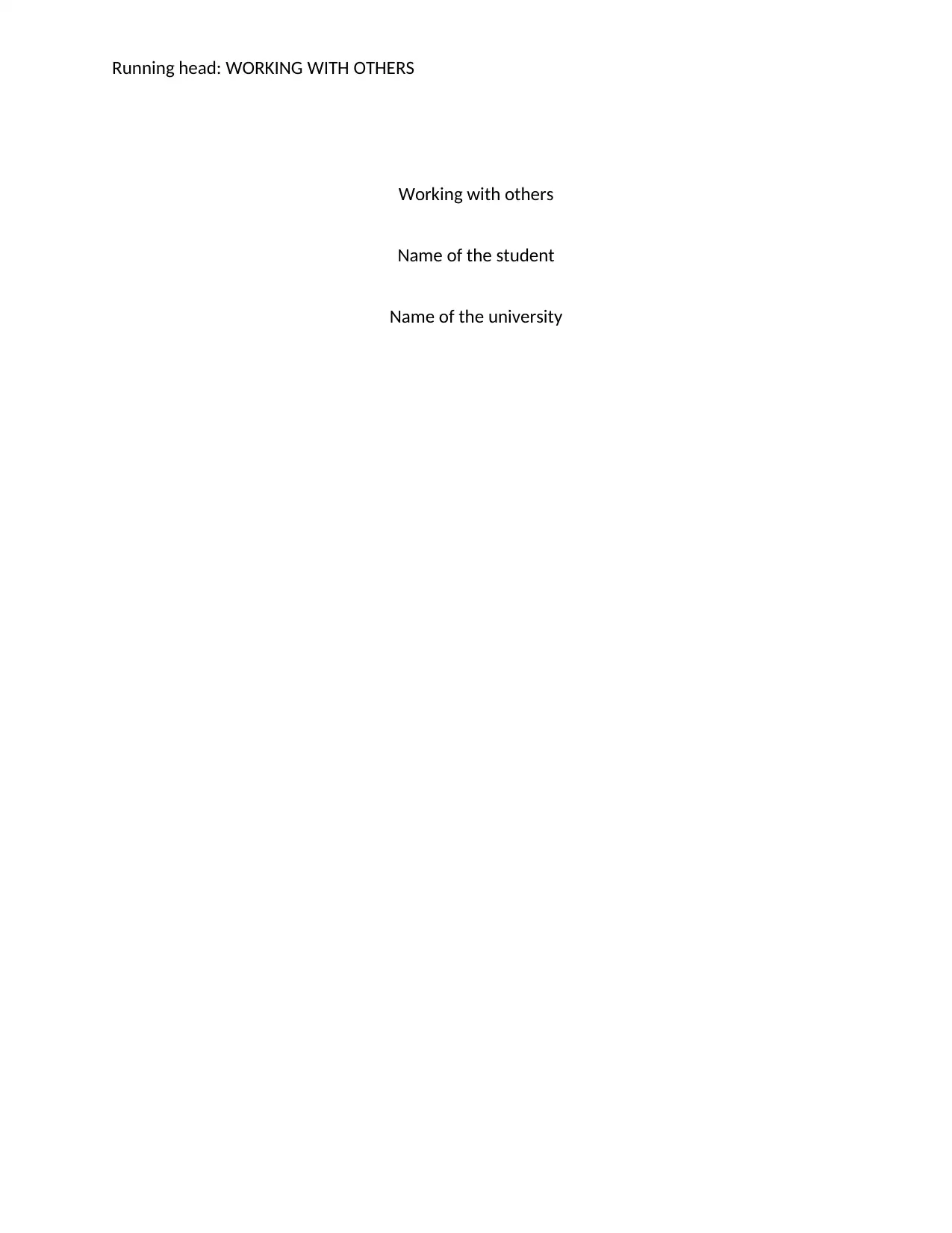
Running head: WORKING WITH OTHERS
Working with others
Name of the student
Name of the university
Working with others
Name of the student
Name of the university
Paraphrase This Document
Need a fresh take? Get an instant paraphrase of this document with our AI Paraphraser
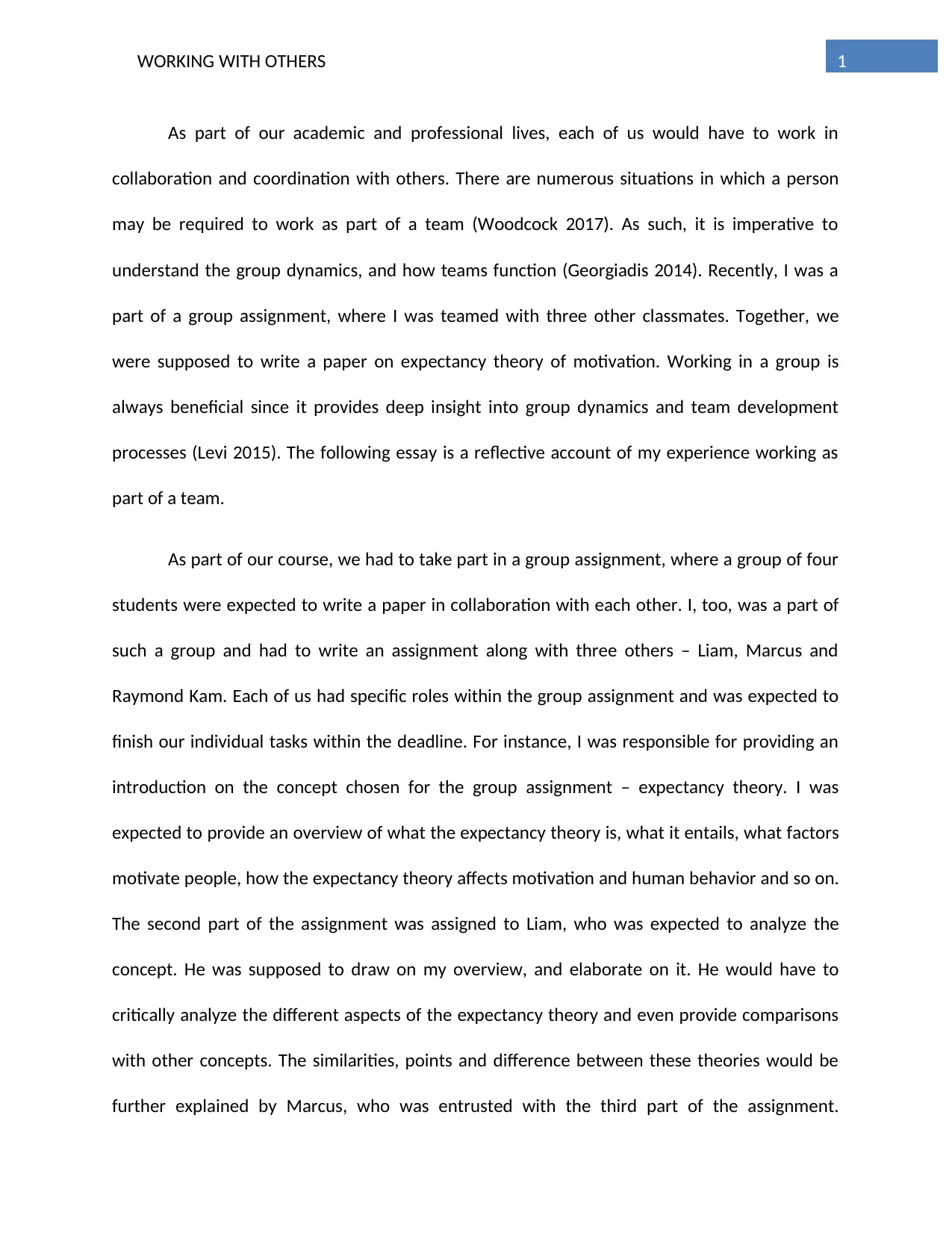
1WORKING WITH OTHERS
As part of our academic and professional lives, each of us would have to work in
collaboration and coordination with others. There are numerous situations in which a person
may be required to work as part of a team (Woodcock 2017). As such, it is imperative to
understand the group dynamics, and how teams function (Georgiadis 2014). Recently, I was a
part of a group assignment, where I was teamed with three other classmates. Together, we
were supposed to write a paper on expectancy theory of motivation. Working in a group is
always beneficial since it provides deep insight into group dynamics and team development
processes (Levi 2015). The following essay is a reflective account of my experience working as
part of a team.
As part of our course, we had to take part in a group assignment, where a group of four
students were expected to write a paper in collaboration with each other. I, too, was a part of
such a group and had to write an assignment along with three others – Liam, Marcus and
Raymond Kam. Each of us had specific roles within the group assignment and was expected to
finish our individual tasks within the deadline. For instance, I was responsible for providing an
introduction on the concept chosen for the group assignment – expectancy theory. I was
expected to provide an overview of what the expectancy theory is, what it entails, what factors
motivate people, how the expectancy theory affects motivation and human behavior and so on.
The second part of the assignment was assigned to Liam, who was expected to analyze the
concept. He was supposed to draw on my overview, and elaborate on it. He would have to
critically analyze the different aspects of the expectancy theory and even provide comparisons
with other concepts. The similarities, points and difference between these theories would be
further explained by Marcus, who was entrusted with the third part of the assignment.
As part of our academic and professional lives, each of us would have to work in
collaboration and coordination with others. There are numerous situations in which a person
may be required to work as part of a team (Woodcock 2017). As such, it is imperative to
understand the group dynamics, and how teams function (Georgiadis 2014). Recently, I was a
part of a group assignment, where I was teamed with three other classmates. Together, we
were supposed to write a paper on expectancy theory of motivation. Working in a group is
always beneficial since it provides deep insight into group dynamics and team development
processes (Levi 2015). The following essay is a reflective account of my experience working as
part of a team.
As part of our course, we had to take part in a group assignment, where a group of four
students were expected to write a paper in collaboration with each other. I, too, was a part of
such a group and had to write an assignment along with three others – Liam, Marcus and
Raymond Kam. Each of us had specific roles within the group assignment and was expected to
finish our individual tasks within the deadline. For instance, I was responsible for providing an
introduction on the concept chosen for the group assignment – expectancy theory. I was
expected to provide an overview of what the expectancy theory is, what it entails, what factors
motivate people, how the expectancy theory affects motivation and human behavior and so on.
The second part of the assignment was assigned to Liam, who was expected to analyze the
concept. He was supposed to draw on my overview, and elaborate on it. He would have to
critically analyze the different aspects of the expectancy theory and even provide comparisons
with other concepts. The similarities, points and difference between these theories would be
further explained by Marcus, who was entrusted with the third part of the assignment.
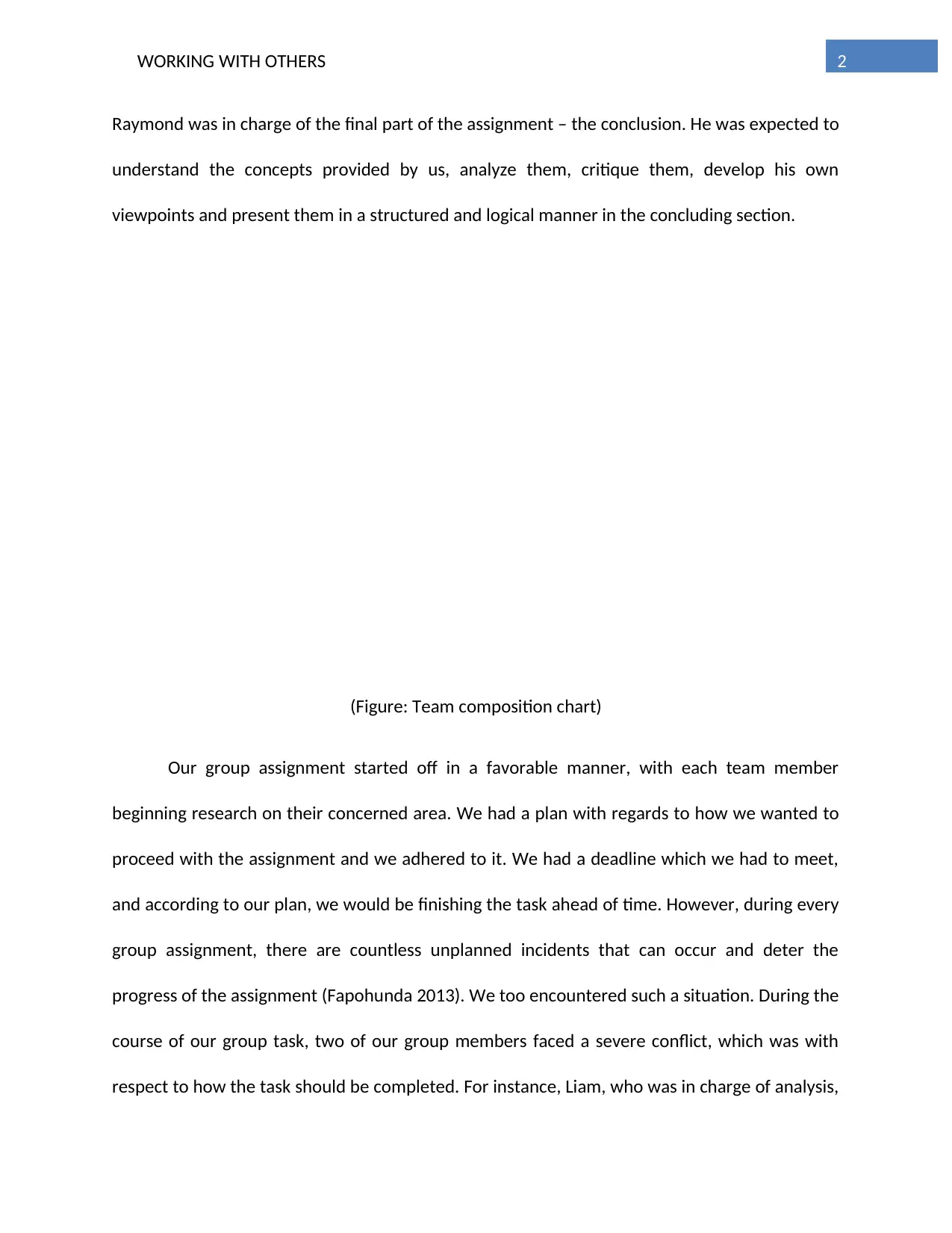
2WORKING WITH OTHERS
Raymond was in charge of the final part of the assignment – the conclusion. He was expected to
understand the concepts provided by us, analyze them, critique them, develop his own
viewpoints and present them in a structured and logical manner in the concluding section.
(Figure: Team composition chart)
Our group assignment started off in a favorable manner, with each team member
beginning research on their concerned area. We had a plan with regards to how we wanted to
proceed with the assignment and we adhered to it. We had a deadline which we had to meet,
and according to our plan, we would be finishing the task ahead of time. However, during every
group assignment, there are countless unplanned incidents that can occur and deter the
progress of the assignment (Fapohunda 2013). We too encountered such a situation. During the
course of our group task, two of our group members faced a severe conflict, which was with
respect to how the task should be completed. For instance, Liam, who was in charge of analysis,
Raymond was in charge of the final part of the assignment – the conclusion. He was expected to
understand the concepts provided by us, analyze them, critique them, develop his own
viewpoints and present them in a structured and logical manner in the concluding section.
(Figure: Team composition chart)
Our group assignment started off in a favorable manner, with each team member
beginning research on their concerned area. We had a plan with regards to how we wanted to
proceed with the assignment and we adhered to it. We had a deadline which we had to meet,
and according to our plan, we would be finishing the task ahead of time. However, during every
group assignment, there are countless unplanned incidents that can occur and deter the
progress of the assignment (Fapohunda 2013). We too encountered such a situation. During the
course of our group task, two of our group members faced a severe conflict, which was with
respect to how the task should be completed. For instance, Liam, who was in charge of analysis,
⊘ This is a preview!⊘
Do you want full access?
Subscribe today to unlock all pages.

Trusted by 1+ million students worldwide
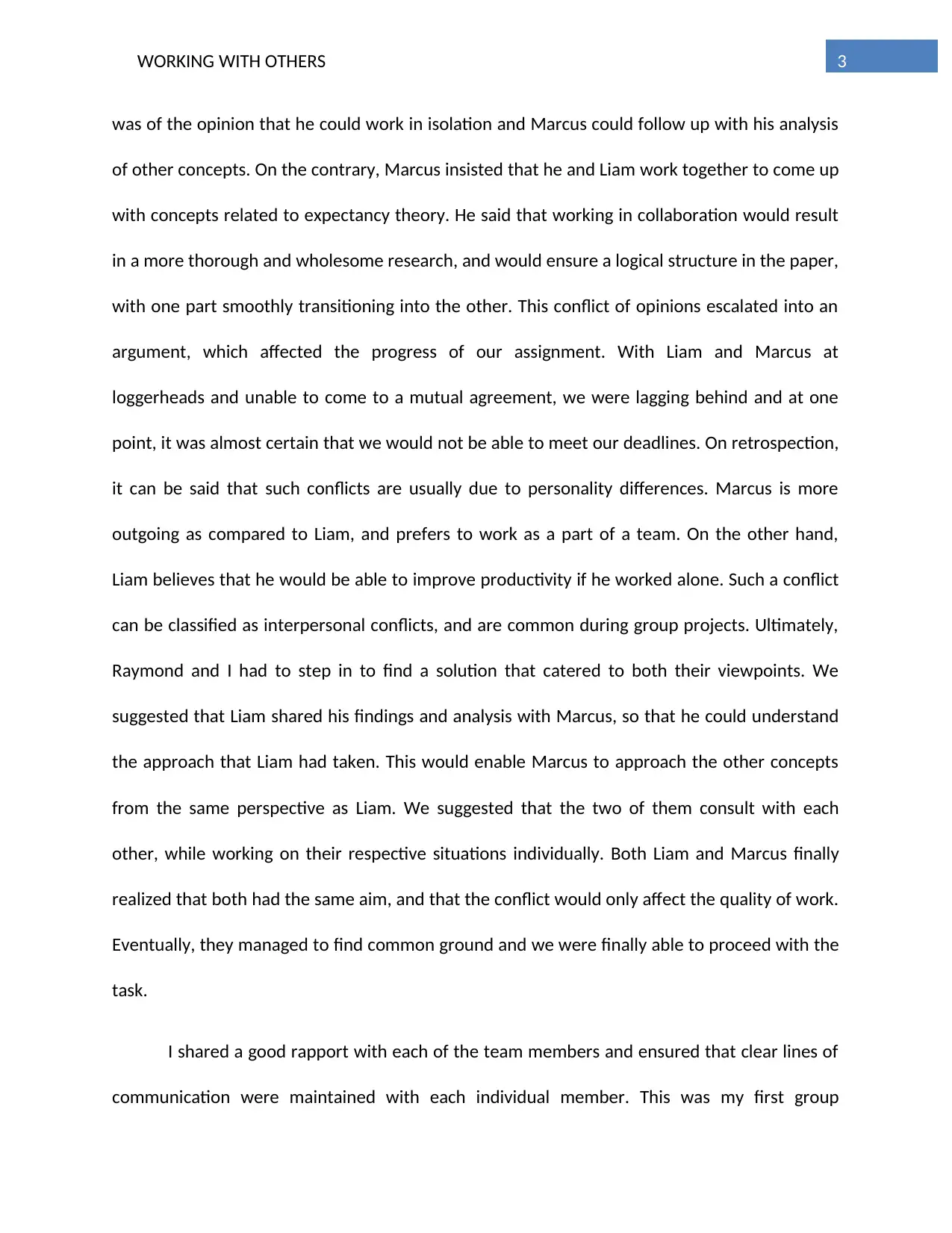
3WORKING WITH OTHERS
was of the opinion that he could work in isolation and Marcus could follow up with his analysis
of other concepts. On the contrary, Marcus insisted that he and Liam work together to come up
with concepts related to expectancy theory. He said that working in collaboration would result
in a more thorough and wholesome research, and would ensure a logical structure in the paper,
with one part smoothly transitioning into the other. This conflict of opinions escalated into an
argument, which affected the progress of our assignment. With Liam and Marcus at
loggerheads and unable to come to a mutual agreement, we were lagging behind and at one
point, it was almost certain that we would not be able to meet our deadlines. On retrospection,
it can be said that such conflicts are usually due to personality differences. Marcus is more
outgoing as compared to Liam, and prefers to work as a part of a team. On the other hand,
Liam believes that he would be able to improve productivity if he worked alone. Such a conflict
can be classified as interpersonal conflicts, and are common during group projects. Ultimately,
Raymond and I had to step in to find a solution that catered to both their viewpoints. We
suggested that Liam shared his findings and analysis with Marcus, so that he could understand
the approach that Liam had taken. This would enable Marcus to approach the other concepts
from the same perspective as Liam. We suggested that the two of them consult with each
other, while working on their respective situations individually. Both Liam and Marcus finally
realized that both had the same aim, and that the conflict would only affect the quality of work.
Eventually, they managed to find common ground and we were finally able to proceed with the
task.
I shared a good rapport with each of the team members and ensured that clear lines of
communication were maintained with each individual member. This was my first group
was of the opinion that he could work in isolation and Marcus could follow up with his analysis
of other concepts. On the contrary, Marcus insisted that he and Liam work together to come up
with concepts related to expectancy theory. He said that working in collaboration would result
in a more thorough and wholesome research, and would ensure a logical structure in the paper,
with one part smoothly transitioning into the other. This conflict of opinions escalated into an
argument, which affected the progress of our assignment. With Liam and Marcus at
loggerheads and unable to come to a mutual agreement, we were lagging behind and at one
point, it was almost certain that we would not be able to meet our deadlines. On retrospection,
it can be said that such conflicts are usually due to personality differences. Marcus is more
outgoing as compared to Liam, and prefers to work as a part of a team. On the other hand,
Liam believes that he would be able to improve productivity if he worked alone. Such a conflict
can be classified as interpersonal conflicts, and are common during group projects. Ultimately,
Raymond and I had to step in to find a solution that catered to both their viewpoints. We
suggested that Liam shared his findings and analysis with Marcus, so that he could understand
the approach that Liam had taken. This would enable Marcus to approach the other concepts
from the same perspective as Liam. We suggested that the two of them consult with each
other, while working on their respective situations individually. Both Liam and Marcus finally
realized that both had the same aim, and that the conflict would only affect the quality of work.
Eventually, they managed to find common ground and we were finally able to proceed with the
task.
I shared a good rapport with each of the team members and ensured that clear lines of
communication were maintained with each individual member. This was my first group
Paraphrase This Document
Need a fresh take? Get an instant paraphrase of this document with our AI Paraphraser
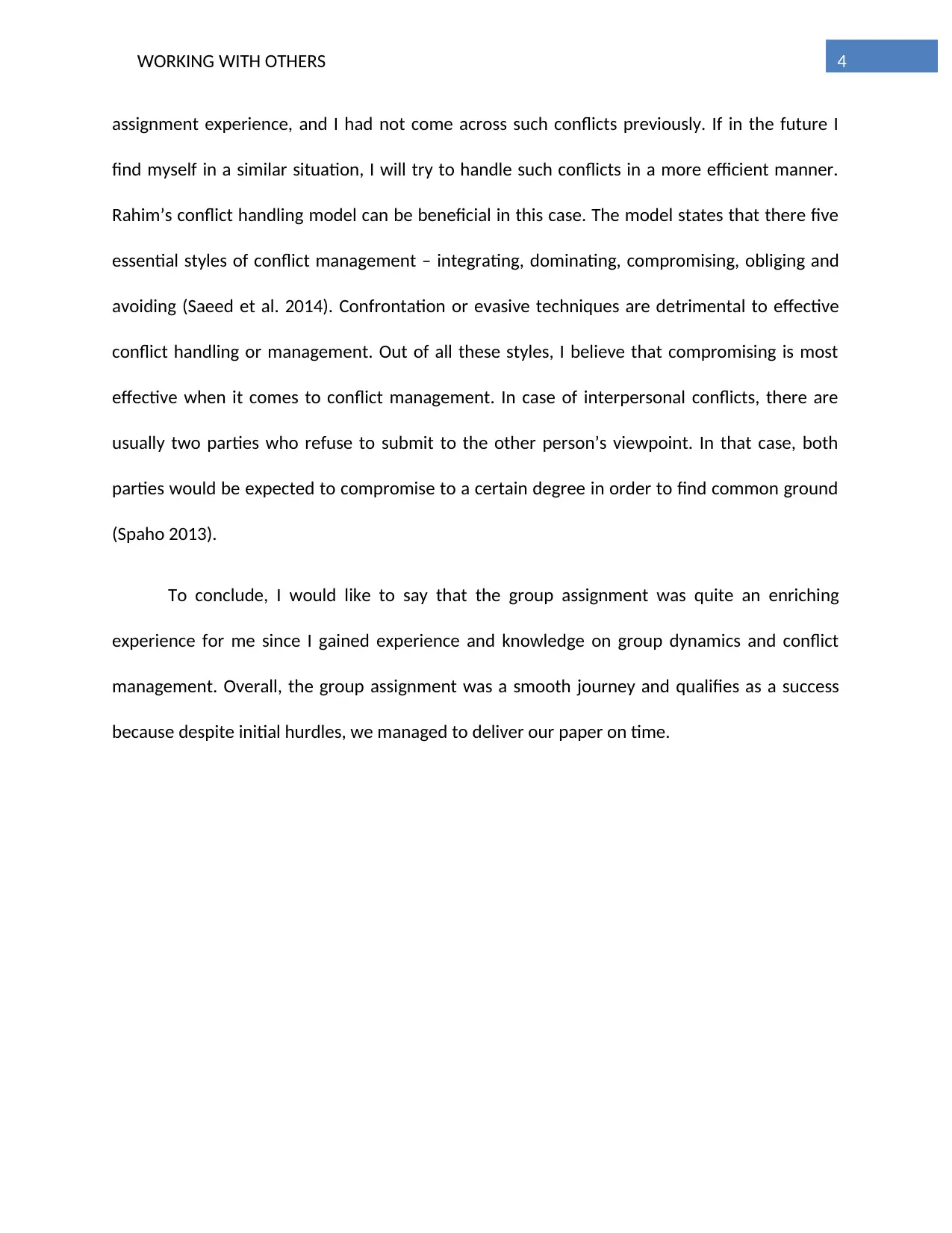
4WORKING WITH OTHERS
assignment experience, and I had not come across such conflicts previously. If in the future I
find myself in a similar situation, I will try to handle such conflicts in a more efficient manner.
Rahim’s conflict handling model can be beneficial in this case. The model states that there five
essential styles of conflict management – integrating, dominating, compromising, obliging and
avoiding (Saeed et al. 2014). Confrontation or evasive techniques are detrimental to effective
conflict handling or management. Out of all these styles, I believe that compromising is most
effective when it comes to conflict management. In case of interpersonal conflicts, there are
usually two parties who refuse to submit to the other person’s viewpoint. In that case, both
parties would be expected to compromise to a certain degree in order to find common ground
(Spaho 2013).
To conclude, I would like to say that the group assignment was quite an enriching
experience for me since I gained experience and knowledge on group dynamics and conflict
management. Overall, the group assignment was a smooth journey and qualifies as a success
because despite initial hurdles, we managed to deliver our paper on time.
assignment experience, and I had not come across such conflicts previously. If in the future I
find myself in a similar situation, I will try to handle such conflicts in a more efficient manner.
Rahim’s conflict handling model can be beneficial in this case. The model states that there five
essential styles of conflict management – integrating, dominating, compromising, obliging and
avoiding (Saeed et al. 2014). Confrontation or evasive techniques are detrimental to effective
conflict handling or management. Out of all these styles, I believe that compromising is most
effective when it comes to conflict management. In case of interpersonal conflicts, there are
usually two parties who refuse to submit to the other person’s viewpoint. In that case, both
parties would be expected to compromise to a certain degree in order to find common ground
(Spaho 2013).
To conclude, I would like to say that the group assignment was quite an enriching
experience for me since I gained experience and knowledge on group dynamics and conflict
management. Overall, the group assignment was a smooth journey and qualifies as a success
because despite initial hurdles, we managed to deliver our paper on time.
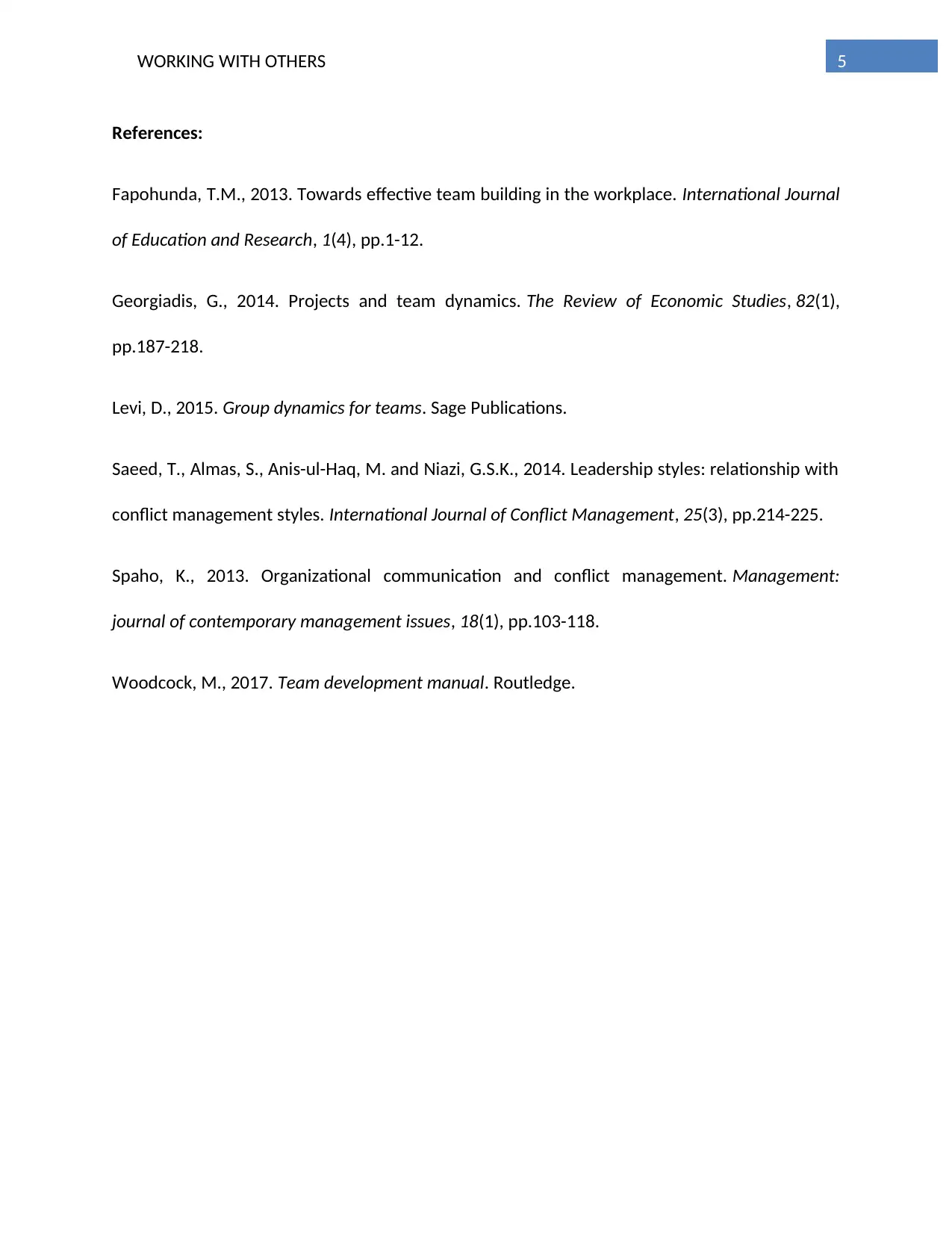
5WORKING WITH OTHERS
References:
Fapohunda, T.M., 2013. Towards effective team building in the workplace. International Journal
of Education and Research, 1(4), pp.1-12.
Georgiadis, G., 2014. Projects and team dynamics. The Review of Economic Studies, 82(1),
pp.187-218.
Levi, D., 2015. Group dynamics for teams. Sage Publications.
Saeed, T., Almas, S., Anis-ul-Haq, M. and Niazi, G.S.K., 2014. Leadership styles: relationship with
conflict management styles. International Journal of Conflict Management, 25(3), pp.214-225.
Spaho, K., 2013. Organizational communication and conflict management. Management:
journal of contemporary management issues, 18(1), pp.103-118.
Woodcock, M., 2017. Team development manual. Routledge.
References:
Fapohunda, T.M., 2013. Towards effective team building in the workplace. International Journal
of Education and Research, 1(4), pp.1-12.
Georgiadis, G., 2014. Projects and team dynamics. The Review of Economic Studies, 82(1),
pp.187-218.
Levi, D., 2015. Group dynamics for teams. Sage Publications.
Saeed, T., Almas, S., Anis-ul-Haq, M. and Niazi, G.S.K., 2014. Leadership styles: relationship with
conflict management styles. International Journal of Conflict Management, 25(3), pp.214-225.
Spaho, K., 2013. Organizational communication and conflict management. Management:
journal of contemporary management issues, 18(1), pp.103-118.
Woodcock, M., 2017. Team development manual. Routledge.
⊘ This is a preview!⊘
Do you want full access?
Subscribe today to unlock all pages.

Trusted by 1+ million students worldwide
1 out of 6
Related Documents
Your All-in-One AI-Powered Toolkit for Academic Success.
+13062052269
info@desklib.com
Available 24*7 on WhatsApp / Email
![[object Object]](/_next/static/media/star-bottom.7253800d.svg)
Unlock your academic potential
Copyright © 2020–2025 A2Z Services. All Rights Reserved. Developed and managed by ZUCOL.




